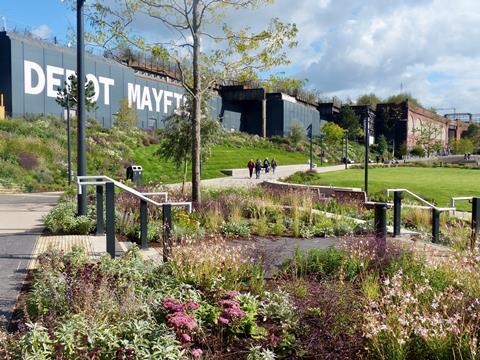The worker bee is a longstanding symbol of the city, representing industrious Mancunians working hard together to achieve. More than 150 years on, that spirit continues to be embodied in the relentless pace of development and regeneration in the city and across the region, says Mei Ren, partner at Buro Happold
The term “Northern Powerhouse” is a fading but still uncomfortable political memory for many people, particularly those who reside in Manchester. The long overdue Northern Powerhouse Rail project as well as the severely delayed HS2 rail link should by now be joining the city with the capital, but the latter now faces a likely 20-year wait for the go-ahead.

While the levelling-up fund is providing some welcome alternative investment, Greater Manchester is not hanging around to see what comes next.
The pace of change in Greater Manchester is accelerating post-pandemic, driven by unabated demand for both housing and student accommodation, and a continued thirst for cultural and sporting venues to showcase its passions on both stage and field with major investment happening in these sectors. The relocation of government departments to the region also looks set to boost demand for well-located flexible commercial office space.
Manchester does not just want to jostle with Birmingham and Glasgow for the title of the UK’s second city. It wants to stand tall on the world stage
Manchester has a combined sense of pride and scale of ambition, as well as strong collective leadership from the Greater Manchester Combined Authority (GMCA). It does not just want to jostle with Birmingham and Glasgow for the title of the UK’s second city. It wants to stand tall on the world stage. That “can-do” attitude means that development and regeneration happen, and at a pace often not seen elsewhere.
This comes in particular from harnessing the partnership between the public and private sectors, which provides a unique opportunity to leverage the levelling-up fund for building sustainable local development.
The announcement in June of an additional £72m of Rail North investment will spur further growth for the area. The Rail North committee, now chaired by the mayor Andy Burnham, set out its ambitions to better connect the city with the rest of the region. This comes on the back of initiatives such as the £2 flat fare “Bee Network” yellow buses that have already been rolled out.
Improved transport links are one of the keys to super-charging the region further. Being able to move people around efficiently to work, live and relax unlocks strategic planning, placemaking, development and regeneration opportunities in both existing places and new pockets previously not considered. This will have a huge impact on reducing geographical disparity across the region and create regenerative longevity.
It also meets one of the area’s key objectives – to improve people’s quality of life by improving the air quality by taking cars off the road. Indeed, since the pandemic Buro Happold has seen an acceleration of net zero ambitions in the region, and strong demand to make all those “build back better” pledges a reality.

And although the cost and availability of construction materials and looming threat of a recession may temper the pace of change in some sectors, I believe public-private partnerships will continue to maintain development and regeneration levels in the next few years. The Trafford JV partnership with Bruntwood, and Stockport’s mayoral development corporation are just two examples that demonstrate this drive towards more flexible and ambitious thinking.
It will also further encourage local councils to think holistically and consider the “big picture”, not just the next flagship project. We are already seeing this mindset through public-private sector development elsewhere in the North-west in places such as Huyton, Wigan and Stoke.
At Buro Happold we feel a sense of Mancunian pride in projects such as Mayfield Park, the city’s first new public park for more than 100 years and a public-private joint venture partnership between LCR, Manchester city council, Transport for Greater Manchester and regeneration specialist U+I.
The imaginative and cutting-edge regeneration of waterside warehouses and stranded assets has created the mixed-use destination Kampus, and the Manchester Jewish Museum is a newly established landmark that has picked up awards for its sensitive restoration and expansion.
Already the fastest growing UK tech hub outside London, Manchester Metropolitan University’s new £35m SODA (School of Digital Arts) building was partially funded by Northern Powerhouse investment. Consolidating the facilities from multiple university sites into a purpose-built interdisciplinary school across various departments, it won a RIBA North West award in May.
Manchester refuses to stand still, and we are so proud to play a part in making that happen, now and into the future
Science and technology has been targeted as another growth area, and Manchester’s ambitions are no less than to compete with the lauded “golden triangle” formed by the universities in London, Cambridge and Oxford. Manchester Science Park – now a community of more than 150 science and tech businesses – embodies this spirit.
ID Manchester, set over 9ha of the former University of Manchester north campus, is being developed as a place for entrepreneurs, students, professionals and families alike. Its ambition is to be the world’s next great innovation district, a launchpad for ideas that grow into the discoveries, technologies and businesses that define the future.
Quite simply, Manchester refuses to stand still, and we are so proud to play a part in making that happen, now and into the future. What is good for Manchester and the North-west is good for the UK as a whole.
We cannot wait to see where Manchester goes next. Long may the buzz continue.



























No comments yet